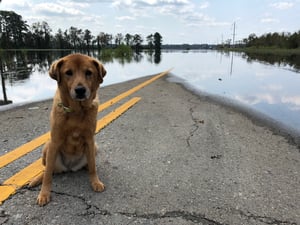 Natural disasters can strike at a moment’s notice. A typical day can be turned upside down by severe weather causing damage and destruction to your home, cars, and other personal property. Or what about an unexpected fire that leaves your house in ashes?
Natural disasters can strike at a moment’s notice. A typical day can be turned upside down by severe weather causing damage and destruction to your home, cars, and other personal property. Or what about an unexpected fire that leaves your house in ashes?
There are several plans you can follow to keep your family safe. However, have you thought about your pets? They bring happiness, entertainment, and companionship and make life enjoyable.
Having a plan in place to take care of their needs before and after a disaster is just as important.
1. Create a plan.
If you need to leave your home, do you have a place to stay? Maybe your local hotel allows pets to stay with you for an additional charge. Also, consider asking a trusted neighbor, friend or family member. Having a conversation before a disaster strikes is critical to making sure your pets are adequately cared for. Unfortunately, if you go to a Red Cross shelter, they don’t accept pets. Only service animals are allowed.
2. Make sure your pets can be identified.
It’s important to make sure pets’ collars and tags are updated. If you recently moved, did you put the new address on their tags? While this is a simple change, It’s probably the last thing on your mind. If your pet has been microchipped, that’s excellent. This is one of the best ways to ensure you’re reunited with your pets if they’re lost for a short time after a disaster.
3. Have pet carriers ready to go.
While leaving your pet carriers in plain site can be stressful for your pets, it’s wise to keep them in a place that’ll make them readily available in case of an emergency. Keeping them buried in your basement or up in your attic can make them difficult to access when time is of the essence. At a minimum, always keep leashes or harnesses near the door.
4. Practice makes perfect.
In April, many schools and businesses practice sheltering in place or evacuating for specific weather events or situations. Consider practicing with your family and pets. For pets other than dogs, a car ride can be stressful. By practicing beforehand, your pets will hopefully become more comfortable with the process and going in the car. Then when an emergency develops, it’s not a traumatic experience for them.
5. Play Hide and Seek.
Stressful situations may cause your pets to hide. Be sure you know all their hiding spots in case you must evacuate your home quickly. Our cat likes to hide in the laundry basket, under my daughter’s bed, and inside our couch. If we can’t find him, those are the first three places we look.
6. Create an emergency kit.
If you live in a snowy climate, you may want to pack an emergency kit just in case you get stranded in your car during a winter storm. Creating a kit for your pets is no different. Your pet’s kit should include:
-
Additional leashes or harnesses
-
Food and drinking water
-
Bowls and litter boxes
-
Plastic bags for waste
-
Medications
-
Medical records
-
Photos of your pets
-
Favorite bed, blanket, and toys
7. Create a comfortable room.
If you encounter severe weather and decide to shelter in place, make sure the room is comfortable for you and your pet. Preferably, the room should be clear of windows and items that could be toxic or dangerous to them.
8. Inspect your property.
When you return home, check for things that may have moved or spilled. Check the floor to make sure there are no sharp items that could cause injury. Also look for exposed wires or dirty standing water. In both cases, you’ll want to make sure they’re remedied quickly.
9. Contact your veterinarian.
If you return home and your pets seem out of sorts, contact your veterinarian for a thorough checkup. Pets can become unpredictable if they’re scared or sick.
Do you have any suggestions or information you’d like to share? I’d love to hear from you. Please share them in the box below.





